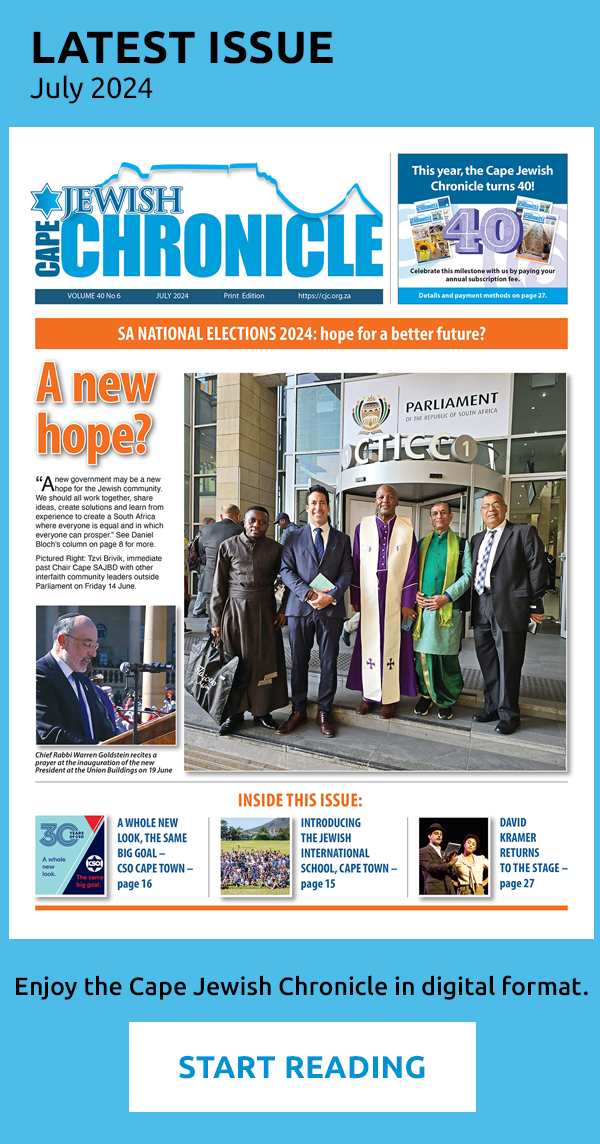By Gwynne Robins
Malmesbury is situated in an area known as the Swartland in the heart of the country’s wheat farmland.
According to the Beth Hatsfutsoth book on South African Country Communities, Malmesbury held its first minyan in 1895, meaning that it already had ten observant Jewish men living there. One was Israel Resnick, who moved to Malmesbury in 1896 — a speculator and dairy farmer. During the South African War, at least 15 Jewish members of the Western Province Mounted Rifles attended services in Malmesbury. Other early settlers were Dr R Rosenzweig, who arrived in 1900, as did Kleiman Horwitz, a general dealer, Tuvye Kretzmar who arrived in 1903, a general dealer on the Main Road, and Abraham Beyer, a produce buyer.
The first Malmesbury Hebrew Congregation appears to have started around 1900, and by 1904 there were 246 Jews in Malmesbury, of whom 114 were members of the congregation. It was reorganised on 26 September 1904 — kol HaMoed Sukkot — as Ohel Jacob Hebrew Congregation with B Krafchik, president of the Malmesbury Zionist Association (established the year before, in 1903) as its president and Kretzmar as its honorary treasurer. Krafchik represented both organisations in the delegation to petition against the 1903 Immigration Bill and was a delegate on 4 September 1904 at the inaugural meeting of the Jewish Board of Deputies, under Morris Alexander, and Krafchik was elected a member of the Board in 1906.
In 1906, they decided to build a synagogue of their own and the following year, a Talmud Torah was founded. An illustrated booklet titled Floods and Storms; a Pictorial Record of the Memorable Storms in the Cape Colony issued by the Cape Times Limited, Cape Town in September 1905 (price 6d) describes unprecedented heavy rainfall in the South West Cape on 28 September, when a tornado struck the village of Malmesbury removing the roofs of over 75 buildings followed by floods that overflowed its banks, causing widespread destruction. It included a photo of the ruins in the Main Street, and another showing that almost all the buildings in the Main Street, where the Jews had their shops, had their roofs blown off.
It was not until 11 November 1911 that the foundation stone of the beautiful Ohel Jacob Synagogue was laid by A Katz and B Alswang. It was designed and built by Max Goldman. ‘How goodly are thy tents O Jacob’ can still be seen inscribed in Hebrew on its entrance archway. It was opened by the Rev A P Bender of the Cape Town Hebrew Congregation on 16 May 1912, and the gilt key presented to him on the occasion is now on display at the Cape SAJBD.
With a Jewish population of about 50 families in the 1920s, they could enjoy a stable and rich Jewish life. A mikvah was built behind the synagogue in the 1920s, and in 1922, through the generosity of local farmer Piet van der Westhuizen, land was acquired for a cemetery. He donated land on his farm Rozenberg with a servitude stating that “this land is always to remain for the Jews.” He also paid towards the cost of the Taharah house and the wall around the cemetery and was a generous donor of cash and cattle to the Zionist bazaars. An illuminated address of thanks and appreciation was presented to him by the community which he proudly hung in the entrance to his farmhouse.
The town was the regional centre for Jewish life and provided kosher food to the surrounding areas, including Piketberg. For the High Holy Days, the congregation would be augmented by Jews who travelled in from nearby villages such as Mamre, Darling, Kalabaskraal and Piketberg. All Jewish businesses closed for the Holy Days. Malmesbury had a Jewish Burial Society, a Jewish Helping Hand Society, a Zionist Association, a Women’s Zionist Society, a Jewish Ladies Benevolent Society, a Union of Jewish Women, a Junior Maccabean Society, a Maccabean Association which “fostered the aims of Judaism and Zionism”, and an Orphan Aid Society to support Oranjia.
Zionist bazaars were held in the Town Hall. Die Joodse Basaar with the unusual Joodse kos and delicatessen was well patronised by the gentile inhabitants. They sent five delegates to attend the 1926 Zionist Congress in Cape Town. In 1931, they opened a Talmud Torah with 28 pupils and in 1935, board chairperson Morris Alexander laid the foundation stone for a Talmud Torah hall that could seat 400 people with a stage. The hall was opened by Cape Town mayor Louis Gradner.
Antisemitism did not leave Malmesbury alone and Weichard and his Greyshirts held meetings there in 1935, attracting 400 people on at least three occasions in 1936, attracting 600 people at the last one. Dr Donges (later state president) and Dr Verwoerd (later Prime Minister) spoke against Jewish immigration at a protest meeting. In a 1943 election speech, National Party candidate for Malmesbury, M S Loubser, harangued about strangers from overseas who were making huge profits and buying up fixed properties while Afrikaner blood was flowing up north.
However, by then Malmesbury was caught up in the exodus of Jewish families from country communities, and by 1940, there was only one pupil in the cheder. The following year it was still possible to get a minyan for chagim and, as realists, the Talmud Torah hall was sold to Mr Bloch. Even as late as 1977, arrangements were being made for their children to be taught, but when there were only four families left in 1971, the synagogue was closed, being bought by Dr Goldman, the son of the original builder. The Malmesbury Hebrew Congregation was dissolved, its assets were taken over by the Jewish Board of Deputies and the contents of the synagogue —including the bimah, four Sifrei Torah, Aron Kodesh, pulpit and benches— were transferred to Herzlia School’s synagogue Minyan Yosef through the efforts of Bennie Resnick.
On 29 April 1974, the Malmesbury synagogue was deconsecrated and transferred to the local municipality. Since 1991, the Ohel Jacob Synagogue at 1 Prospect Street, Malmesbury, has been used as the town museum and Tuvye’s son, Julius, who was then retired and living in Cape Town, was called in to help the curator with the history of the Jewish community. The Malmesbury Museum has been a heritage site since 1994 and has been cared for and well maintained. The Museum contains a leaflet documenting the history of the Jews of the town and an explanation of various items, ceremonies and festivals. It includes the story of Tobias Kretzmar and his shop in Main Street.
By 1994, the Talmud Torah hall had become a supermarket and the cemetery was badly vandalised. Some of the money from the sale of the Talmud Torah was used to restore the cemetery, repair sixty graves and the Taharah house. The cemetery was rededicated and descendants of Piet van der Westhuizen attended the ceremony and offered to maintain the cemetery which was on their farm.
By 1996, there was only one Jewish family left in Malmesbury.
The Country Communities Subcommittee of the Cape SAJBD looks after the cemeteries of the defunct country communities. For queries, contact stuart@ctjc.co.za.

Cape SA Jewish Board of Deputies website: www.capesajbd.org, Instagram, and Facebook page.
Published in the print edition of the December 2020/January 2021 issue.
Download the Dec/Jan issue PDF here.
Visit our Portal to the Jewish Community to see a list of all the Jewish organisations in Cape Town with links to their websites.
Subscribe to the Cape Jewish Chronicle and never miss another issue!
Follow Chronicle: Facebook | Instagram | Twitter | LinkedIn










